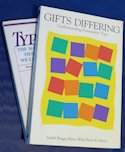
- About the MBTI
- Verify Your MBTI Type
- Personality Patterns
- MBTI Articles & Resources
- Article Directory for Educators & Students
- Books on Personality Types
- Emotional Intelligence & Personality Type
- Career Planning & MBTI
- MBTI Business Applications
- Lenore Thomson - Carl Jung Personality Type
- Site Map - Master Directory of All Articles
- MBTI Consultant Links
- Personality Type Workshops & Conferences
- Links to Other Type Websites
- Murder Mystery Business Theatre
- About Us
Articles on MBTI ® applications & Personality Types
Article Index
Page 1. 8 colors of fitness
Page 2. The 16 fitness personality types
The 8 Colors of Exercise Fitness
An interview with Suzanne Brue (ENFJ), author of The 8 Colors of Fitness. Interviewed by Linda Berens (INTP)
LB (Linda Berens): Suzanne, what is the 8 Colors of Fitness?
SB (Suzanne Brue): The 8 Colors of Fitness ™ is a personality centered approach to exercise grounded in the personality type framework popularized by the Myers-Briggs Type Indicator® instrument.
The 8 Colors is based on 8 preference pairs each corresponding to a Color. By understanding your Fitness Personality you gain an understanding of your motivational patterns, preferred interactions, and environments, and can more effectively choose specific forms of physical activity that are best for you and you will stick with. For instance, some people are traditional and conservative in their approach to exercise while others seek variety and cutting-edge information. Some enjoy solitude and consider exercise a moving meditation while others prefer a fast-paces class with energetic music. In exercise as in everything else, it's "different strokes for different folks."
LB: Why did you decide to focus on exercise and type?
SB: It combines two of my passions-type and fitness. I have studied type for many years, and also have been an avid exerciser. I made the connection between type and exercise in 2001 while observing my mother (ESFJ) in a physical therapy session. I noticed that the physical therapist was being vague in his instructions. I thought to myself, "not good." I could see that he wasn't getting through to her about what she needed to do to heal her rotator cuff. I made some suggestions to the physical therapist such as to teach her the exercises step-by- step, make sure she was comfortable that her form was correct, and to be very specific about how many sets and reps she should do of each exercise. I also suggested that he give her positive feedback when she was doing each exercise correctly. My mother was very pleased with these recommendations, and went on to a better recovery.
I remember being excited by this insight and immediately saw the application to exercise- an Ni moment. I suppose I wanted to find a way to use what I knew about type to help improve people's lives. I was curious about the exercise patterns of the different types. Why is it that in spite of their best intentions, the majority of the population has difficulty sticking to an exercise program, while others are able to stay active year after year? I wanted to understand the personality piece--it became a fascinating puzzle.
LB: What did you do next?
SB: The very next thing I did was interview several people with ESFJ preferences to learn about their approach to fitness. They had similar comments---wanting to be given information step-by-step, wanting very specific instructions and requiring assurance that they were doing their exercise safely and correctly. Also, positive feedback was important.
LB: It seems from a temperament perspective, your whole relationship with type and exercise wasn’t about the ‘exercise.’ I hear a lot of Catalyst (aka NF or Idealist) temperament needs of unique identity and deeper meaning or purpose.
SB: Yes, I agree with that. It’s hard for me to get excited about something that doesn’t touch, as you say, ‘the needs of my unique identity or have a deeper meaning or purpose’. Previously I had worked with type and organizations around leadership, communication and teamwork, but found it boring. Great work had been done by other people (like you!). I didn’t think I had much to contribute. Type and exercise had been talked about, but not studied. I wanted to study it. This new application held deeper meaning and purpose for me. Good point!
LB: So, how did you go about studying this?
SB: I developed a questionnaire to interview people of all types who had been successfully exercising for at least a year. I consulted a research professor at The University of Vermont so that I was confident that I was doing good research.
LB: What was your approach to make this good research?
SB: I followed his guidelines:
-
What did I want to learn?
-
Design questions based on what I want to learn
-
Stay open to the emerging process of asking questions. Open ended interview.
-
Get a good sample size—at least 10 of each of the 16 types.
I actually got about 30 people of each type with an abundance of some types, like ENFPs. I interviewed about 300 people on the phone and in person. Another 100 people responded to a questionnaire on my website. I also collected information in workshops. While my research was primarily in the United States, my sample includes respondents from Canada, England, Norway, Sweden, Egypt, and New Zealand. I’m still interviewing people—it’s always fascinating.
LB: How did you analyze the data?
SB: I organized the interviews by clustering the types by the preferred perceiving processes (Se, Si, Ne, Ni). The perceiving processes seemed to have the most to do with the experience of exercise and key to people’s success. I looked at the questions, and looked at the responses of people, and saw patterns. For example, I saw safety in exercise as a prominent theme in the types that prefer Si (ESTJ, ESFJ, ISTJ, ISFJ). For Ne (ENTP, ENFP, INTP, INFP), it was all about distraction—engaging in an activity they could focus on, and get exercise along the way. Also, convenience was essential of Ne types. Safety was rarely brought up.
LB: So you pulled out the central themes, and then did you check them out with others?
SB: Yes, starting in 2002 I wrote articles for the Bulletin of Psychological Type on exercise and the different processes, with stories that people could relate to. I got feedback from the articles and continued to question people as I saw the patterns emerge. For instance, when I noticed the Greens (ISTP, ISFP) consistently reported their attraction to being in nature (preferably alone) and observing their physical surroundings, I asked them to describe these experiences. When I saw the preference for advance planning with the Golds (ESTJ, ESFJ), I’d question them about how they went about planning their workout week, and made changes.
When I discovered that connecting with people around training programs is often key for Silvers (ENTP, ENFP), I might ask them the specifics of those connections.
LB: Why another terminology other than the type code?
SB: Throughout the research process, I became aware that certain attributes of each pair reminded me of colors that resonated with the physical energy of the type. For instance—Green for the nature loving ISTPs and ISFPs, and Blue for the conscientious and committed ISTJs and ISFJs. The color code evolved as an accessible format that people could identify with—easier than the 4 letter type code.
LB: What did you do with the Thinking and Feeling preferences?
SB: I found that the judging processes (T and F) weren’t as essential as the perceiving processes, but did play a role. I substituted the words Efficiency for Thinking and Harmony for Feeling to avoid any misrepresentations of Thinking and Feeling. These terms resonate with people very well.
For instance, I’m a Purple Harmony (ENFJ). When it comes to exercise, I share Ni in the auxiliary position with Purple Efficients (ENTJ). We both are disciplined initiators and approach exercise like a job. For cardio, we gravitate toward repetitive activities (running, biking, cardio machines in the gym) that do not require too much attention. We enjoy being distracted by letting our thoughts roam (Ni). However, we differ, in that Purple Efficients, for example, prefer an impersonal approach when working out with a personal trainer—wanting to get down to business right. As s Purple Harmony (ENFJ) I’m inclined to a more personal relationship with a trainer, exchanging pleasantries, chatting about each others’ lives, etc.
LB: So there is some verification that the clustering of the 8 types fits and that it works?
SB: Yes— the clustering around the perceiving processes resonates with people, as evidenced by the response to The 8 Colors. It’s been very exciting. At this point, 50,000 people have visited my website, http://www.the8colors.com from every state and 50 foreign countries. I have a licensing agreement with several fitness clubs. They’ve all renewed their license so it must be working. It is very popular with their members. I’m in contact with other fitness clubs about licensing The 8 Colors. Several major corporations have shown interest in using it in their wellness programs. Physical therapists and wellness coaches are also picking it up and I’ve been presenting at fitness and wellness conferences. Articles on The 8 Colors have appeared in major fitness/wellness magazines as well as on-line publications.
LB: I can’t help but notice that when you group people by preferences for Sensing and Perceiving (Se) and Sensing and Judging (Si) you have also tapped into temperament as well. My sense is that the information you get when you do this is somewhat stronger because it taps into the core needs of the temperaments. Do you see this with the data you collected?
SB: I have been very focused on Jung’s model. Now that you mention it—that’s very interesting. However, the NJs (Whites and Purples) share very distinctive qualities—approaching exercise as a job, responsive to their own independent personal vision. With the NPs (Saffrons and Silvers), they share a need to disguise exercise into another experience. Convenience and flow is a priority for them too.
LB: Well, I’d say that with NJs and NPs you are likely getting to an aspect of Interaction Styles, so you’ve tapped into two of the three models we use with type.
SB: Good observation---thanks.
> > > Next Page - Why not just 4 Types & the 8 Exercise Fitness Personalities
® MBTI, Myers-Briggs, Meyers Briggs, and Myers-Briggs Type Indicator are registered trademarks or trademarks of the Myers-Briggs Type Indicator Trust in the United States and other countries (aka meyers briggs or myers briggs).
|
|
© Published by Ross Reinhold & Reinhold Development 1997 - 2023
Privacy Policy About Us



